Hyundai Ioniq Electric 2018 Owner's Manual
Manufacturer: HYUNDAI, Model Year: 2018, Model line: Ioniq Electric, Model: Hyundai Ioniq Electric 2018Pages: 541, PDF Size: 19.83 MB
Page 481 of 541

I-13
User settings mode..........................................................3-84
Vanity mirror lamp........................................................3-101
Vehicle certification label .................................................8-7
Vehicle data collection and event data recorders .............F-8
Vehicle identification number (VIN) ................................8-7
Vehicle load limit ............................................................5-96Tire loading information label....................................5-96
Vehicle modification .........................................................F-7
Vehicle Stability Management (VSM)............................5-33
Volume and weight ...........................................................8-5
Warning and indicator lights...........................................3-58 Anti-lock Brake System (ABS) warning light ...........3-61
AUTO HOLD indicator light .....................................3-63
Autonomous Emergency Braking (AEB) warning light ..........................................................3-64
Charging indicator light .............................................3-59
Charging system warning light ..................................3-62
Cruise indicator light ..................................................3-67
Cruise SET indicator light..........................................3-67 ECO mode indicator light ..........................................3-68
Electric power steering (EPS) warning light .............3-62
Electronic brake force warning light..........................3-61
Electronic parking brake warning light......................3-63
Electronic Stability Control (ESC) indicator light .....3-65
Electronic Stability Control (ESC) OFF indicator light..................................................3-66
High beam indicator light ..........................................3-67
High voltage battery low level warning light ............3-59
Immobilizer indicator light ........................................3-66
Lane Departure Warning System (LDWS) warning light ...........................................................3-64
LED headlamp warning light .....................................3-64
Light ON indicator light .............................................3-67
Low tire pressure warning light .................................3-62
Master warning light ..................................................3-65
Parking brake & brake fluid warning light ................3-60
Power down warning light .........................................3-58
Ready indicator ..........................................................3-58
Regenerative brake warning light ..............................3-59
Seat belt warning light ...............................................3-59
Service warning light .................................................3-58
SPORT mode indicator light ......................................3-68
Supplemental restraint system warning light .............3-59
Turn signal indicator light ..........................................3-67
Warning light ..................................................................3-58
Washer fluid ....................................................................7-17\
I
Index
U
V
W
Page 482 of 541
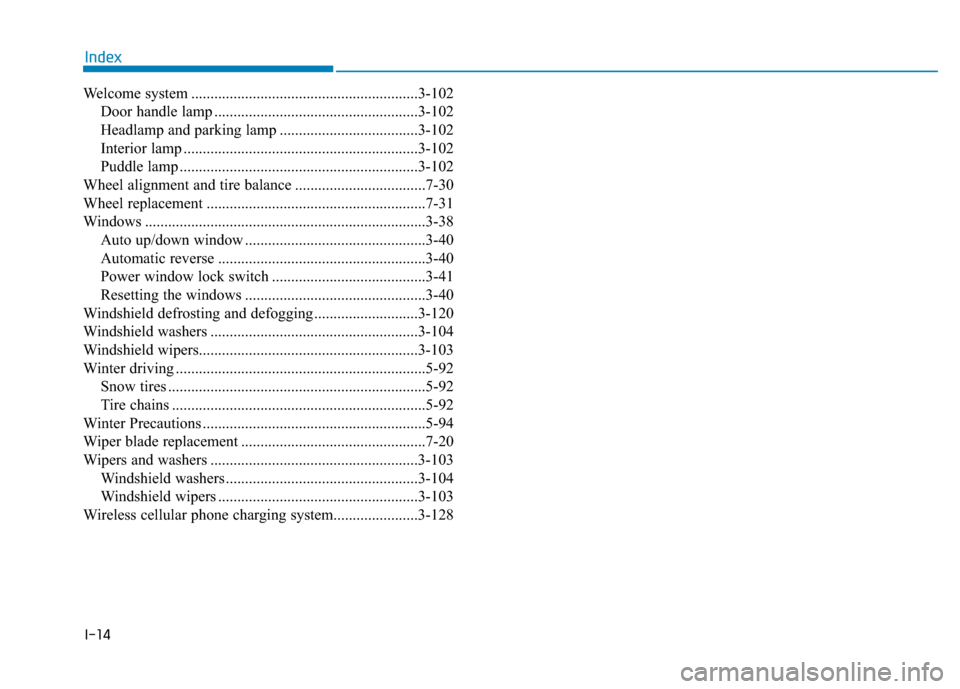
I-14
Welcome system ...........................................................3-102Door handle lamp .....................................................3-102
Headlamp and parking lamp ....................................3-102
Interior lamp .............................................................3-102
Puddle lamp ..............................................................3-102
Wheel alignment and tire balance ..................................7-30
Wheel replacement .........................................................7-31
Windows ........................................................................\
.3-38 Auto up/down window ...............................................3-40
Automatic reverse ......................................................3-40
Power window lock switch ........................................3-41
Resetting the windows ...............................................3-40
Windshield defrosting and defogging ...........................3-120
Windshield washers ......................................................3-104
Windshield wipers........................................................\
.3-103
Winter driving .................................................................5-92 Snow tires ...................................................................5-92
Tire chains ..................................................................5-92
Winter Precautions ..........................................................5-94
Wiper blade replacement ................................................7-20
Wipers and washers ......................................................3-103 Windshield washers ..................................................3-104
Windshield wipers ....................................................3-103
Wireless cellular phone charging system......................3-128
Index
Page 483 of 541
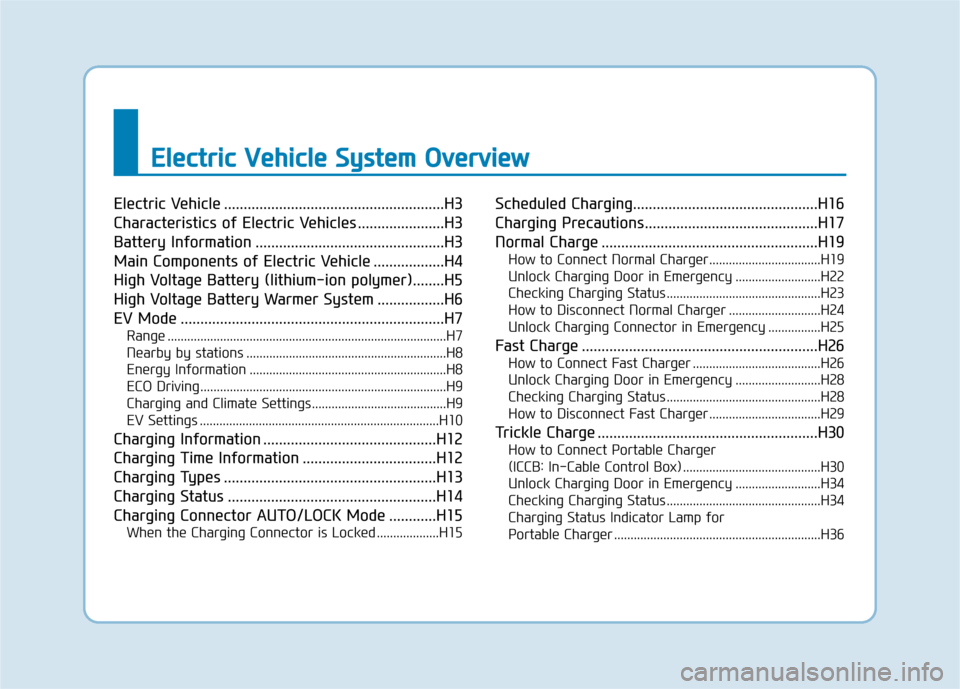
E
El
le
e c
ct
tr
r i
ic
c
V
V e
eh
h i
ic
c l
le
e
S
S y
ys
st
te
e m
m
O
O v
ve
e r
rv
v i
ie
e w
w
Electric Vehicle ........................................................H3
Characteristics of Electric Vehicles ......................H3
Battery Information ................................................H3
Main Components of Electric Vehicle ..................H4
High Voltage Battery (lithium-ion polymer)........H5
High Voltage Battery Warmer System .................H6
EV Mode ...................................................................H7
Range ........................................................................\
.............H7
Nearby by stations .............................................................H8
Energy Information ............................................................H8
ECO Driving ........................................................................\
...H9
Charging and Climate Settings.........................................H9
EV Settings ........................................................................\
.H10
Charging Information ............................................H12
Charging Time Information ..................................H12
Charging Types ......................................................H13
Charging Status .....................................................H14
Charging Connector AUTO/LOCK Mode ............H15
When the Charging Connector is Locked ...................H15
Scheduled Charging...............................................H16
Charging Precautions............................................H17
Normal Charge .......................................................H19
How to Connect Normal Charger..................................H19
Unlock Charging Door in Emergency ..........................H22
Checking Charging Status ...............................................H23
How to Disconnect Normal Charger ............................H24
Unlock Charging Connector in Emergency ................H25
Fast Charge ............................................................H26
How to Connect Fast Charger .......................................H26
Unlock Charging Door in Emergency ..........................H28
Checking Charging Status ...............................................H28
How to Disconnect Fast Charger ..................................H29
Trickle Charge ........................................................H30
How to Connect Portable Charger
(ICCB: In-Cable Control Box) ..........................................H30
Unlock Charging Door in Emergency ..........................H34
Checking Charging Status ...............................................H34
Charging Status Indicator Lamp for
Portable Charger ...............................................................H36
Page 484 of 541
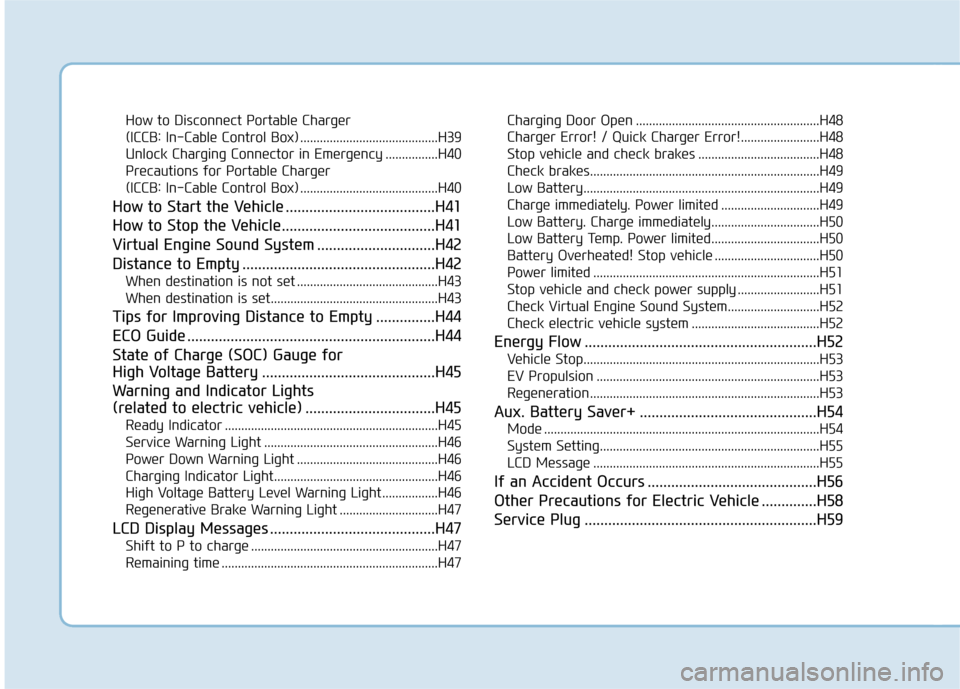
How to Disconnect Portable Charger
(ICCB: In-Cable Control Box) ..........................................H39
Unlock Charging Connector in Emergency ................H40
Precautions for Portable Charger
(ICCB: In-Cable Control Box) ..........................................H40
How to Start the Vehicle ......................................H41
How to Stop the Vehicle.......................................H41
Virtual Engine Sound System ..............................H42
Distance to Empty .................................................H42
When destination is not set ...........................................H43
When destination is set...................................................H43
Tips for Improving Distance to Empty ...............H44
ECO Guide ...............................................................H44
State of Charge (SOC) Gauge for
High Voltage Battery ............................................H45
Warning and Indicator Lights
(related to electric vehicle) .................................H45
Ready Indicator .................................................................H45
Service Warning Light .....................................................H46
Power Down Warning Light ...........................................H46
Charging Indicator Light..................................................H46
High Voltage Battery Level Warning Light .................H46
Regenerative Brake Warning Light ..............................H47
LCD Display Messages ..........................................H47
Shift to P to charge .........................................................H47
Remaining time ..................................................................H47 Charging Door Open ........................................................H48
Charger Error! / Quick Charger Error!........................H48
Stop vehicle and check brakes .....................................H48
Check brakes......................................................................H4\
9
Low Battery........................................................................\
H49
Charge immediately. Power limited ..............................H49
Low Battery. Charge immediately.................................H50
Low Battery Temp. Power limited.................................H50
Battery Overheated! Stop vehicle ................................H50
Power limited .....................................................................H51\
Stop vehicle and check power supply .........................H51
Check Virtual Engine Sound System............................H52
Check electric vehicle system .......................................H52
Energy Flow ...........................................................H52
Vehicle Stop........................................................................\
H53
EV Propulsion ....................................................................H53
Regeneration ......................................................................H5\
3
Aux. Battery Saver+ .............................................H54
Mode ........................................................................\
............H54
System Setting...................................................................H55
LCD Message .....................................................................H55\
If an Accident Occurs ...........................................H56
Other Precautions for Electric Vehicle ..............H58
Service Plug ...........................................................H59
Page 485 of 541
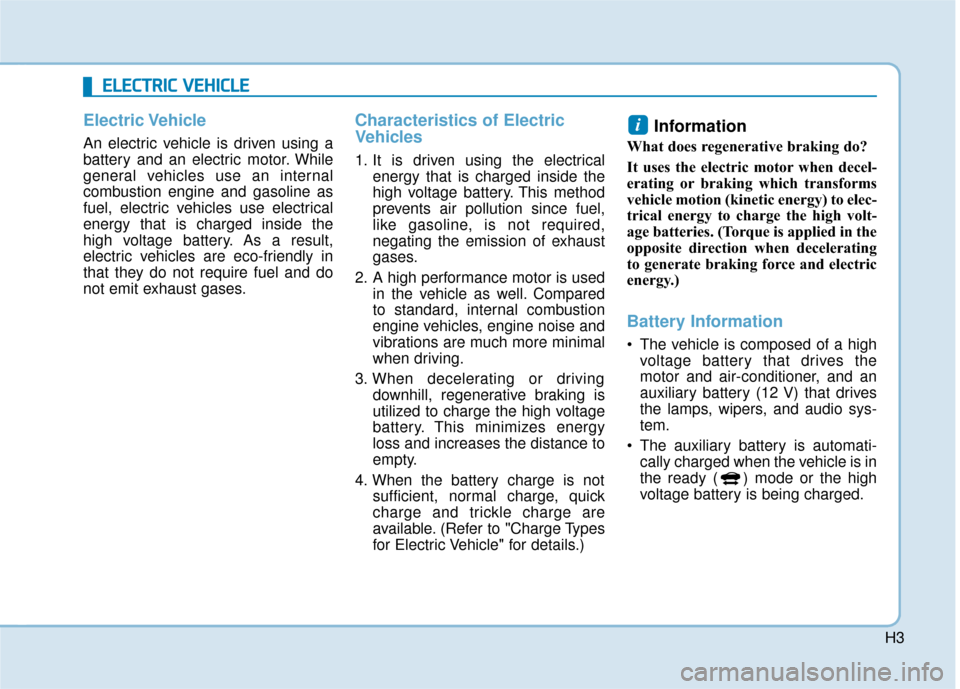
H3
Electric Vehicle
An electric vehicle is driven using a
battery and an electric motor. While
general vehicles use an internal
combustion engine and gasoline as
fuel, electric vehicles use electrical
energy that is charged inside the
high voltage battery. As a result,
electric vehicles are eco-friendly in
that they do not require fuel and do
not emit exhaust gases.
Characteristics of Electric
Vehicles
1. It is driven using the electricalenergy that is charged inside the
high voltage battery. This method
prevents air pollution since fuel,
like gasoline, is not required,
negating the emission of exhaust
gases.
2. A high performance motor is used in the vehicle as well. Compared
to standard, internal combustion
engine vehicles, engine noise and
vibrations are much more minimal
when driving.
3. When decelerating or driving downhill, regenerative braking is
utilized to charge the high voltage
battery. This minimizes energy
loss and increases the distance to
empty.
4. When the battery charge is not sufficient, normal charge, quick
charge and trickle charge are
available. (Refer to "Charge Types
for Electric Vehicle" for details.)
Information
What does regenerative braking do?
It uses the electric motor when decel-
erating or braking which transforms
vehicle motion (kinetic energy) to elec-
trical energy to charge the high volt-
age batteries. (Torque is applied in the
opposite direction when decelerating
to generate braking force and electric
energy.)
Battery Information
• The vehicle is composed of a highvoltage battery that drives the
motor and air-conditioner, and an
auxiliary battery (12 V) that drives
the lamps, wipers, and audio sys-
tem.
The auxiliary battery is automati- cally charged when the vehicle is in
the ready ( ) mode or the high
voltage battery is being charged.
i
E
EL
LE
E C
CT
T R
R I
IC
C
V
V E
EH
H I
IC
C L
LE
E
Page 486 of 541
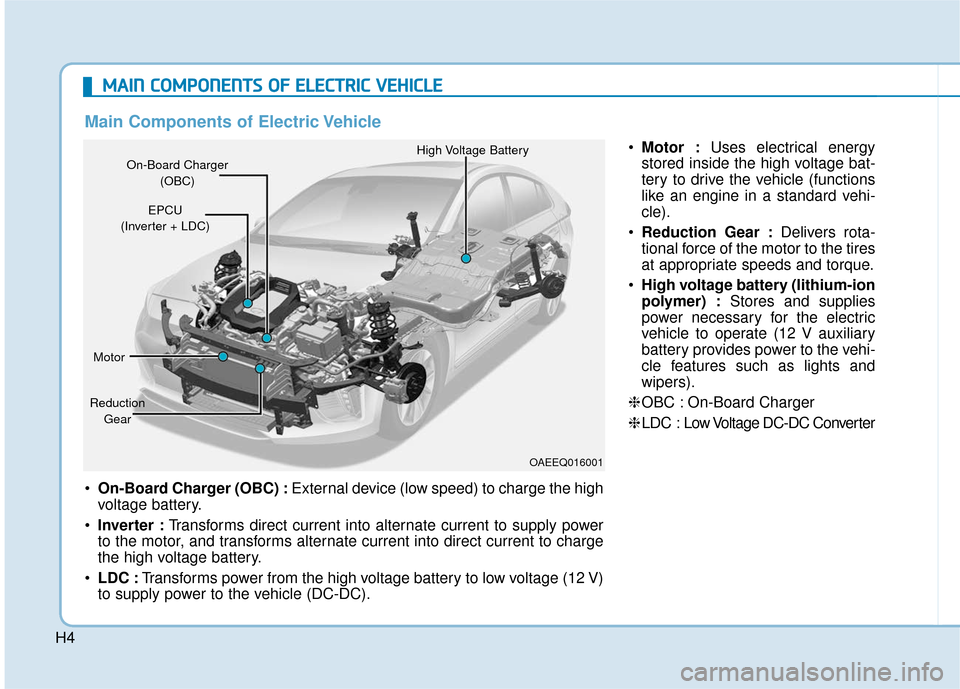
H4
M
MA
AI
IN
N
C
C O
O M
M P
PO
O N
NE
EN
N T
TS
S
O
O F
F
E
E L
LE
E C
CT
T R
R I
IC
C
V
V E
EH
H I
IC
C L
LE
E
On-Board Charger (OBC) : External device (low speed) to charge the high
voltage battery.
Inverter : Transforms direct current into alternate current to supply power
to the motor, and transforms alternate current into direct current to charge
the high voltage battery.
LDC : Transforms power from the high voltage battery to low voltage (12 V)
to supply power to the vehicle (DC-DC).
On-Board Charger
(OBC) High Voltage Battery
EPCU
(Inverter + LDC)
Motor
Reduction Gear
Main Components of Electric Vehicle
Motor : Uses electrical energy
stored inside the high voltage bat-
tery to drive the vehicle (functions
like an engine in a standard vehi-
cle).
Reduction Gear : Delivers rota-
tional force of the motor to the tires
at appropriate speeds and torque.
High voltage battery (lithium-ion
polymer) : Stores and supplies
power necessary for the electric
vehicle to operate (12 V auxiliary
battery provides power to the vehi-
cle features such as lights and
wipers).
❈ OBC : On-Board Charger
❈ LDC : Low V oltage DC-DC Converter
OAEEQ016001
Page 487 of 541
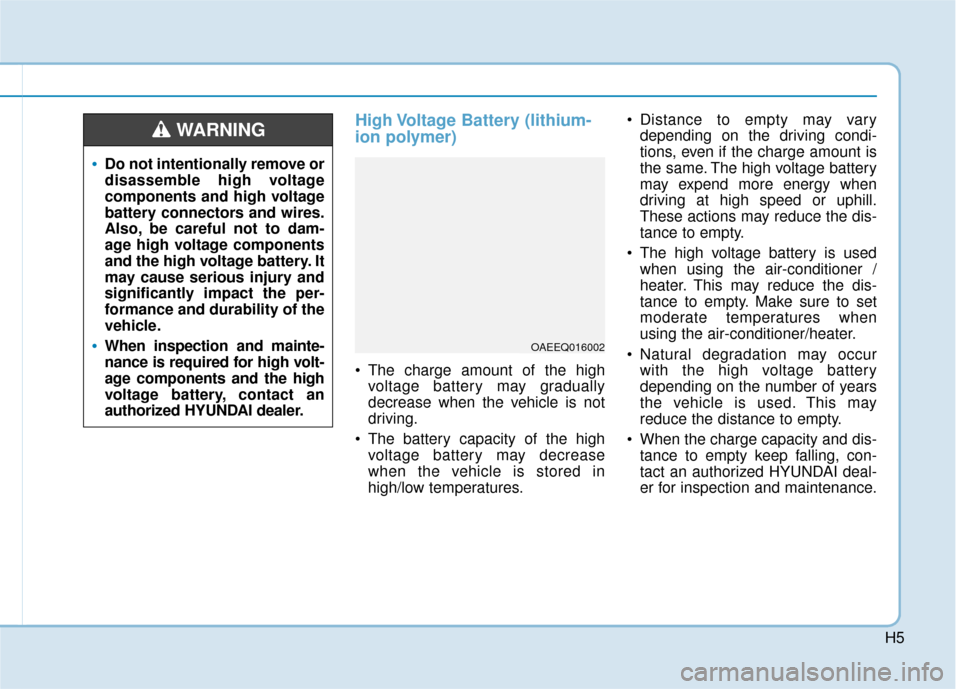
H5
High Voltage Battery (lithium-
ion polymer)
The charge amount of the highvoltage battery may gradually
decrease when the vehicle is not
driving.
The battery capacity of the high voltage battery may decrease
when the vehicle is stored in
high/low temperatures. Distance to empty may vary
depending on the driving condi-
tions, even if the charge amount is
the same. The high voltage battery
may expend more energy when
driving at high speed or uphill.
These actions may reduce the dis-
tance to empty.
The high voltage battery is used when using the air-conditioner /
heater. This may reduce the dis-
tance to empty. Make sure to set
moderate temperatures when
using the air-conditioner/heater.
Natural degradation may occur with the high voltage battery
depending on the number of years
the vehicle is used. This may
reduce the distance to empty.
When the charge capacity and dis- tance to empty keep falling, con-
tact an authorized HYUNDAI deal-
er for inspection and maintenance.
•Do not intentionally remove or
disassemble high voltage
components and high voltage
battery connectors and wires.
Also, be careful not to dam-
age high voltage components
and the high voltage battery. It
may cause serious injury and
significantly impact the per-
formance and durability of the
vehicle.
When inspection and mainte-
nance is required for high volt-
age components and the high
voltage battery, contact an
authorized HYUNDAI dealer.
WARNING
OAEEQ016002
Page 488 of 541
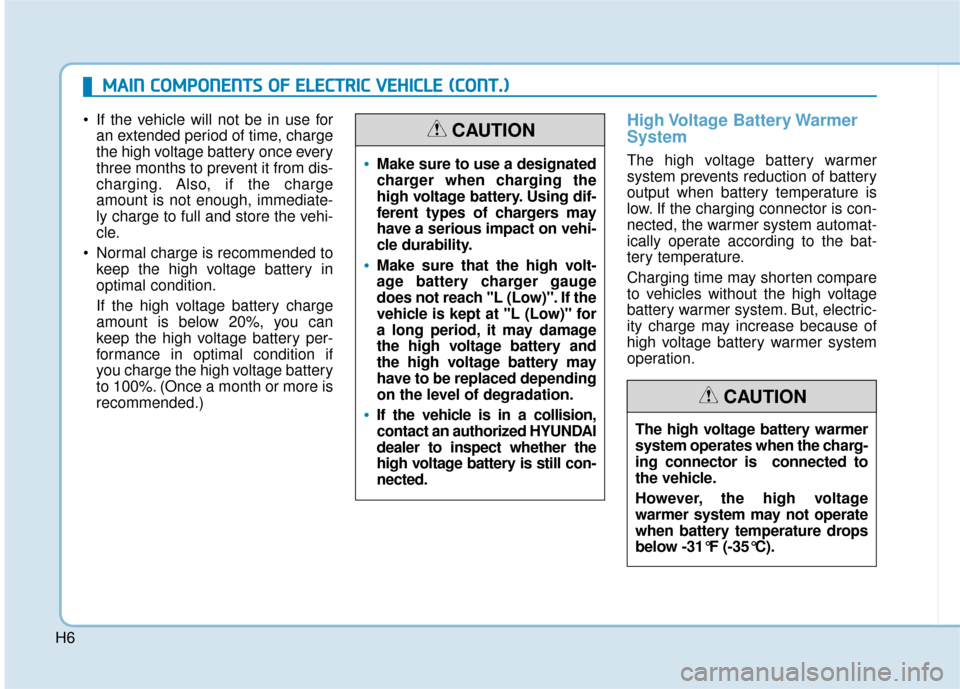
H6
If the vehicle will not be in use foran extended period of time, charge
the high voltage battery once every
three months to prevent it from dis-
charging. Also, if the charge
amount is not enough, immediate-
ly charge to full and store the vehi-
cle.
Normal charge is recommended to keep the high voltage battery in
optimal condition.
If the high voltage battery charge
amount is below 20%, you can
keep the high voltage battery per-
formance in optimal condition if
you charge the high voltage battery
to 100%. (Once a month or more is
recommended.)High Voltage Battery Warmer
System
The high voltage battery warmer
system prevents reduction of battery
output when battery temperature is
low. If the charging connector is con-
nected, the warmer system automat-
ically operate according to the bat-
tery temperature.
Charging time may shorten compare
to vehicles without the high voltage
battery warmer system. But, electric-
ity charge may increase because of
high voltage battery warmer system
operation.Make sure to use a designated
charger when charging the
high voltage battery. Using dif-
ferent types of chargers may
have a serious impact on vehi-
cle durability.
Make sure that the high volt-
age battery charger gauge
does not reach ''L (Low)". If the
vehicle is kept at ''L (Low)" for
a long period, it may damage
the high voltage battery and
the high voltage battery may
have to be replaced depending
on the level of degradation.
If the vehicle is in a collision,
contact an authorized HYUNDAI
dealer to inspect whether the
high voltage battery is still con-
nected.
CAUTION
The high voltage battery warmer
system operates when the charg-
ing connector is connected to
the vehicle.
However, the high voltage
warmer system may not operate
when battery temperature drops
below -31°F (-35°C).
CAUTION
M M A
AI
IN
N
C
C O
O M
M P
PO
O N
NE
EN
N T
TS
S
O
O F
F
E
E L
LE
E C
CT
T R
R I
IC
C
V
V E
EH
H I
IC
C L
LE
E
(
( C
C O
O N
NT
T.
.)
)
Page 489 of 541
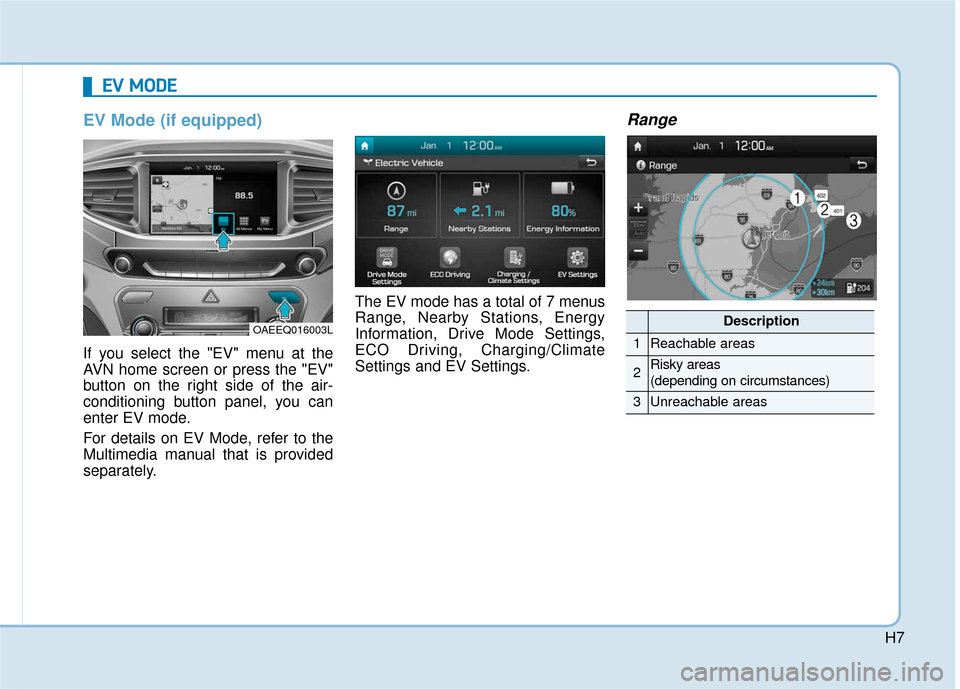
H7
EV Mode (if equipped)
If you select the "EV" menu at the
AVN home screen or press the "EV"
button on the right side of the air-
conditioning button panel, you can
enter EV mode.
For details on EV Mode, refer to the
Multimedia manual that is provided
separately.The EV mode has a total of 7 menus
Range, Nearby Stations, Energy
Information, Drive Mode Settings,
ECO Driving, Charging/Climate
Settings and EV Settings.
Range
E E
V
V
M
M O
OD
DE
E
OAEEQ016003LDescription
1Reachable areas
2Risky areas
(depending on circumstances)
3Unreachable areas
Page 490 of 541
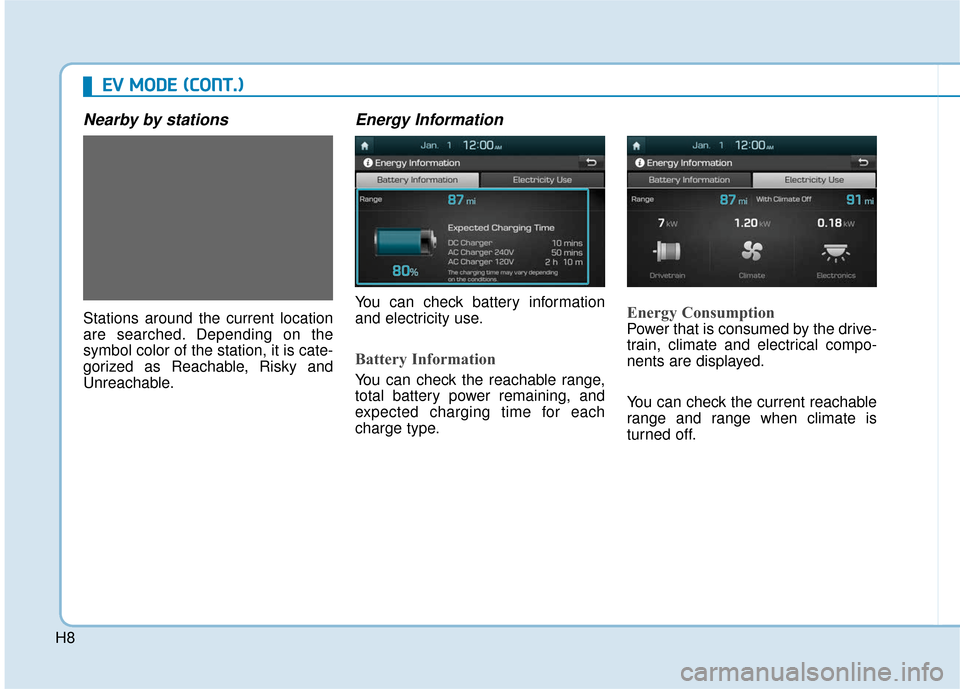
H8
E
EV
V
M
M O
OD
DE
E
(
( C
C O
O N
NT
T.
.)
)
Nearby by stations
Stations around the current location
are searched. Depending on the
symbol color of the station, it is cate-
gorized as Reachable, Risky and
Unreachable.
Energy Information
You can check battery information
and electricity use.
Battery Information
You can check the reachable range,
total battery power remaining, and
expected charging time for each
charge type.
Energy Consumption
Power that is consumed by the drive-
train, climate and electrical compo-
nents are displayed.
You can check the current reachable
range and range when climate is
turned off.